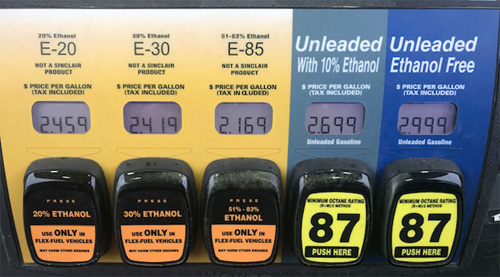Biofuels industry leaders from POET, Growth Energy and CoBank held a Q&A panel session for several hundred farmers at the Farmers Business Network’s Farmer2Farmer conference on Thursday, Dec. 13, in Omaha, Neb. About 2,700 individuals from 42 states across the U.S. registered for the fourth annual event.
Since the panel didn’t get an opportunity to address many questions after the session, a list of responses to the top questions asked has been compiled below.
Higher Ethanol Blends and Autos
Why does E-15 cost more than regular gas when E-85 is a much cheaper cost?
E10 (10% ethanol, 90% gasoline) is typically $.30 less than regular unleaded (gasoline without ethanol) and E15 (15% ethanol, 85% gasoline) is typically 5-10 cents less than E10. Unless someone is pricing wrong, the more ethanol in the fuel results in a decrease in price. So, E85 (85% ethanol, 15% gasoline) would be the least expensive option, but E15 should be less expensive than E10.
Would you discuss POET’s involvement with high octane engines and how ethanol will benefit?
POET is part of group of about 45 organizations called the Ag, Auto, Ethanol Alliance that are dedicated to delivering a high octane fuel and optimized engines for American drivers. The best amount of ethanol for this high octane fuel would be between 25 - 40% ethanol. Obviously, this would significantly increase the market share of ethanol and offer the consumer a better, cheaper, cleaner fuel.
With the Electric car gaining popularity how long before are use of gasoline and ethanol starts to decline? How will there still be demand for ethanol?
The internal combustion engine will be the most competitive technology on the road for a long time to come. And with a better high octane fuel, it will be very hard for electric vehicles to compete in the near term. EV technology is improving, but it does have many issues as well (environmental and economic). Gasoline consumption may decline in the coming years, but ethanol’s percentage in gasoline will increase, which should be net gain for ethanol as a fuel.
Why are autos not interested in a standard octane level?
Autos are very interested in a standard or minimum octane level, but the oil companies have stifled their efforts at every turn. This is why we are working with the Autos to deliver a high octane fuel standard.
What can we as farmers do to increase demand and prove the concept of higher blends to our communities and get our retailers to add higher blends
Use higher blends of ethanol at the pump whenever possible! Ask your retailers for more ethanol and spread the word to use the fuels. Autos will deliver the cars if consumers demand them and retailers will deliver the fuel if consumers demand them.
What effect do you see mandated fuel efficiency standards having on ethanol demand?
In order for autos to deliver better engines and higher efficiency, they need a better fuel – so the higher standards will help ethanol demand.
How does e85 do in our market compared to e15?
All cars 2001 and newer are approved for E15. That’s about 95% of the cars on the road. Only Flex Fuel Vehicles are approved for E85. That’s about 15% of the cars on the road today. Retailers often see an increase in E85 once E15 is offered.
Any thoughts on 91% national standard for all gas?
We’d be ok with that as a start to even higher standards as long as the octane is coming from ethanol and not expensive and toxic aromatics.
Agriculture
Have any of you incorporated cover crops into conventional crops operation and seen an increase in pest pressure?
We’ve done a lot of work with cover crops, especially when we are taking some of the biomass off for cellulosic production. We have not heard increased pest pressure as a result.
What have ethanol byproducts like wet distillers done for the biofuel industry?
Wet distillers grains are great because you save a lot of cost by not having to dry the feed. The trade off is a short shelf life. Increases in inclusion rates, species using distillers and the different forms of distillers grains has made DDGs the number one selling feed stuff in the US.
Policy
Gov Elect Kristi Noem of South Dakota has proposed E-30 or better in all state vehicles. What are some other things like this to promote ethanol use?
Most Midwest states have policies for fueling state flex fuel vehicles with E85, but unfortunately those programs are often underutilized and not properly enforced. Fueling state vehicles with E30 is a great way for government agencies to support family farmers and biofuel jobs in their state. Infrastructure incentives for fuel retailers to offset the cost of installing blender pumps as well as instructions for proper labeling and education programs are also important ways that states can improve consumer access to higher ethanol blends.
You say you want E15 done this year because there are other initiatives to get proposed before 2020. What are POET's next initiatives, after the E15 push?
POET is working on a number of policy initiatives in anticipation that E15 becomes a legal fuel for year-round sale. First and foremost, we must ensure that infrastructure exists to carry additional gallons of ethanol to market as demand for product increases. Likewise, cellulosic tax treatment must be given longer-term certainty so that corn fiber tech remains highly attractive. In addition to these, we are working to determine how best to remove barriers to market entry and unfair regulations that limit the expression of ethanol’s value proposition in the marketplace.
There has been a lot of talk of blend waivers for smaller refiners can you explain what a small refiner is and how it is affecting ethanol demand?
A small refiner is defined by Environmental Protection Agency (EPA) regulations as a refinery that has an average crude oil input no greater than 75,000 barrels per day in 2006. Additionally the refinery cannot have an average aggregate daily crude oil throughput greater than 75,000 barrels per day in the most recent calendar year nor be projected to exceed that threshold for the year or years for which it is applying for an exemption. If a refinery qualifies under this criteria, then it may apply for an exemption. Only if complying with the rule would cause “disproportionate economic hardship” may the refinery be given a waiver. Currently we have seen that the small refiner waivers have lowered blending by 2.25 billion gallons causing a reduction in the price of the RIN and is harming ethanol margins.
Industry
With the reasonable price for corn, and increasing animal feeding, why is the ethanol industry struggling with margins?
Ethanol is oversupplied thanks to the EPA offering oil companies waivers to not have to buy ethanol. This has really hurt ethanol margins, and helped oil company profits at the expense of the consumer. The fuel market is not a free market. It is monopolized by oil. If they are not under any obligation to buy ethanol, they will likely choose to maintain their market share. In addition, tariffs with China have hurt export markets.
Does poet have regrets or should the ethanol industry have considered owning gas stations and/or owning facilities to blend their own gasoline instead of needing oil industry to do the blending?
POET has considered owning retail facilities, but we have opted to just incentivize the best ones to offer higher blends. If the best stations offer E15 and higher blends at lower prices, eventually everyone will have to offer the same to stay competitive.
How can we get more E15/blender pumps at our local stations?
Demand them from the retailers.
What is the 5-10 year plan or goals of the ethanol market?
- Secure Nationwide adoption of E15, which would create demand for 2 billion bushels of new grain and 7 billion gallons of ethanol.
- Open international markets to E10. The global opportunity in just six of the largest fuel markets – China, Brazil, Japan, Canada, Mexico and India – have a combined potential of 12.6 billion gallons of new biofuels demand.
- Commercialize Cellulosic ethanol – creating new markets for additional feedstocks from producers.
- Develop market for higher octane fuels (E20-E40).
Other
Water is becoming a resource concern. Is the use of water in ethanol production a concern and if so how are you addressing it?
POET uses about 2.3 gallons of water per gallon of ethanol produced last I checked. Total water reclaim, or maybe more accurately known as ZLD (zero liquid discharge) is a no discharge system where all water that is brought into the facility is recycled until it evaporates. We do not discharge any of our process water back into streams / rivers.








